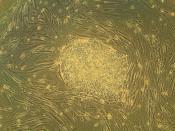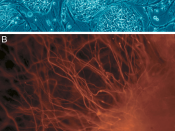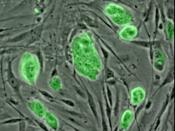Stem cells are master cells in the body that can grow into other types of cells. These cells include red blood cells, which carry oxygen to various parts of the body, white blood cells, which fight off infection in the body, and platelets which help clot blood in the event of a cut. If a person's blood stem cells become damaged due to diseases, cancer, or leukemia, the only hope for a cure is a blood stem cell transplant. This replaces the patient's diseased cells with healthy new stem cells. The cells that will be transplanted in must match the patient's cells to reduce the risk of Graft-Versus-Host Disease (GVHD). The research of these stem cells could help cure many diseases, and disorders in the world today.
The main difference between adult stem cell research, and embryonic stem cell research, is pretty much self explanatory. One is done through adults, whereas embryonic stem cell research is done on embryos.
Embryonic stem cell research is a highly controversial issue, due to the fact that many believe it is killing a baby before it can be born.
Some of the many diseases which could be cured through stem cell research include Parkinson's disease, Alzheimer's disease, arthritis, AIDS, HIV, cancer, spinal cord injuries (or paralysis), and diabetes. These are just some of the many diseases that this research could help to cure completely.
Cord blood research is the research of stem cells in Umbilical cords. After a baby is delivered, the mother's body releases the placenta, the temporary organ that transferred oxygen and nutrients to the baby while in the mother's uterus. Until recently, in most cases the umbilical cord and placenta were discarded after birth without a second thought. But during the 1970s, researchers discovered that umbilical cord blood could supply...


